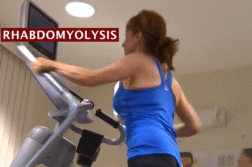SAN DIEGO, Calif. (Ivanhoe Newswire) – Tennis, pickleball, golf, running – millions of people will suffer from over-use injuries this year. The pain can literally stop you in your tracks. When physical therapy and medications don’t help, surgery is usually the only option. But now, there’s a new minimally invasive procedure that will help ease your pain and get you back out doing what you love. P.U.T.
“Running is my meditation,” says Ara Miralles.
Ara started running in college, eventually running marathons, halfs and 10ks, but the wear and tear took its toll.
“It was just to the point where I had, sort of, had enough,” she recalls.
Pain in her Achilles tendon forced Ara to stop running. She tried physical therapy and PRP – nothing helped.
“Her tendon was so inflamed and swollen and painful that you could see it from across the room. It was red and swollen,” says Sports Medicine Specialist at UC San Diego Health, Kenneth Taylor, MD.
Dr. Taylor uses percutaneous ultrasound tenotomy, or P.U.T., to break down the diseased tendon.
“We’re basically taking this needle and we’re sticking it into the disease part of the tendon,” he explains to Ivanhoe.
Increasing the blood flow to the tendon, allowing the body to rebuild itself naturally without surgery.
P.U.T. can be done at the doctor’s office, reducing the time for the procedure as well as costs. With traditional surgery, it takes patients at least six months to recover – with P.U.T., they can be up and running in six weeks.
“To see it actually look normal again in such a short period of time in a marathon runner, I think, is pretty amazing,” Dr. Taylor says in awe.
Ara was back running six weeks after the procedure. Eight months later, she completed the Boston Marathon in three hours and 43 minutes.
Dr. Taylor says pickleball players are also feeling the benefits of P.U.T. This procedure can also be used for shoulders, hips and hamstrings, as well as tennis and golfer’s elbow, jumper’s knee, bone spurs and plantar fasciitis.
Contributors to this news report include: Marsha Lewis, Producer; Matt Goldschmidt, Videographer; Roque Correa, Editor.
To receive a free weekly e-mail on medical breakthroughs from Ivanhoe, sign up at: http://www.ivanhoe.com/ftk
MEDICAL BREAKTHROUGHS
RESEARCH SUMMARY
TOPIC: HEALING RUNNER’S HEEL WITHOUT SURGERY
REPORT: MB #5343
BACKGROUND: Over-use injuries, often stemming from repetitive or excessive strain on specific body parts, can result from a variety of activities. Engaging in physical activities without proper understanding, technique, or awareness of one’s body limits can contribute to overuse injuries. This may include pushing oneself too hard during workouts, neglecting rest days, or participating in activities without adequate preparation. Certain jobs such as working on an assembly line, sewing, playing an instrument, and working on the computer can cause over-use syndrome.
(Source: https://my.clevelandclinic.org/health/diseases/4706-overuse-syndrome-of-the-hands-and-arms
DIAGNOSING: Diagnosing overuse injuries involves a comprehensive approach that combines medical evaluation, patient history, and sometimes diagnostic imaging. Overuse injuries typically result from repetitive stress on specific tissues, leading to inflammation, microtears, and, over time, structural damage. Over-use syndrome may just begin as fatigued feelings in the hands and arms. Musculoskeletal pain in the ligaments and bones commonly follows this and when it gets worse, small parts of soft tissue begin to tear. Common symptoms of over-use iinjuries include swelling, numbness, and gradual loss of ability to move your arms like you once could. The first step in diagnosing over-use injuries is a review of patient history, followed by a physical examination, diagnostic imaging, laboratory tests, specialized tests, consultation with specialists, and elimination of other diagnoses.
(Source: https://my.clevelandclinic.org/health/diseases/4706-overuse-syndrome-of-the-hands-and-arms
NEW TECHNOLOGY: New technology that allows medical professionals to track athletes’ heart rate performance to avoid injuries can be used to improve injury prevention. The technology allows coaches to use the data to tailor special programs for each athlete’s needs and fitness levels. This also helps to avoid over-training athletes and burnout injuries. New aged devices such as GPS tracking devices to monitor training loads, wearable sensors to monitor biomechanics, low-level laser therapy to stimulate tissue healing, and virtual reality to provide a stimulating environment can revolutionize the world of over-use injury and rehabilitation for athletes.
(Source: https://isportz.co/sports/sports-injury-prevention-and-recovery-with-technology/
FOR MORE INFORMATION ON THIS REPORT, PLEASE CONTACT:
Annie Pierce Michelle Brubaker
arpierce@health.ucsd.edu mmbrubaker@health.ucsd.edu
If this story or any other Ivanhoe story has impacted your life or prompted you or someone you know to seek or change treatments, please let us know by contacting Marjorie Bekaert Thomas at mthomas@ivanhoe.com




